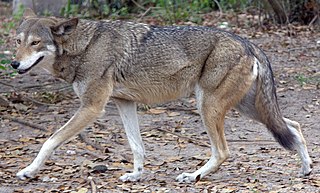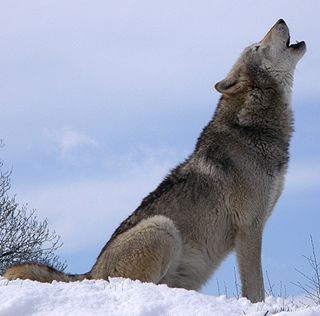Mercury most commonly refers to:

The red wolf is a canine native to the southeastern United States. Its size is intermediate between the coyote and gray wolf.

The dire wolf is an extinct canine. The dire wolf lived in the Americas during the Late Pleistocene and Early Holocene epochs. The species was named in 1858, four years after the first specimen had been found. Two subspecies are recognized: Aenocyon dirus guildayi and Aenocyon dirus dirus. The largest collection of its fossils has been obtained from the Rancho La Brea Tar Pits in Los Angeles.

Canis is a genus of the Caninae which includes multiple extant species, such as wolves, dogs, coyotes, and golden jackals. Species of this genus are distinguished by their moderate to large size, their massive, well-developed skulls and dentition, long legs, and comparatively short ears and tails.
A wasp is a type of flying insect.
Wolfpack or wolf pack may refer to:

The eastern wolf, also known as the timber wolf, Algonquin wolf and eastern timber wolf, is a canine of debated taxonomy native to the Great Lakes region and southeastern Canada. It is considered to be either a unique subspecies of gray wolf or red wolf or a separate species from both. Many studies have found the eastern wolf to be the product of ancient and recent genetic admixture between the gray wolf and the coyote, while other studies have found some or all populations of the eastern wolf, as well as coyotes, originally separated from a common ancestor with the wolf over 1 million years ago and that these populations of the eastern wolf may be the same species as or a closely related species to the red wolf of the Southeastern United States. Regardless of its status, it is regarded as unique and therefore worthy of conservation with Canada citing the population in eastern Canada as being the eastern wolf population subject to protection.
A shark is a cartilaginous, usually carnivorous fish.
Jackal is a small animal in the wolf/dog family of mammals.
The coyote is a species of canine found throughout North and Central America.

A coywolf is a canid hybrid descended from coyotes, eastern wolves, gray wolves, and dogs. All of these species are members of the genus Canis with 78 chromosomes; they therefore can interbreed. One genetic study indicates that these species genetically diverged relatively recently. Genomic studies indicate that nearly all North American gray wolf populations possess some degree of admixture with coyotes following a geographic cline, with the lowest levels occurring in Alaska, and the highest in Ontario and Quebec, as well as Atlantic Canada. Another term for these hybrids is sometimes wolfote.

The Great Plains wolf, also known as the buffalo wolf or loafer, is a subspecies of gray wolf that once extended throughout the Great Plains, from southern Manitoba and Saskatchewan in Canada southward to northern Texas in the United States. The subspecies was thought to be extinct in 1926, until studies declared that its descendants were found in Minnesota, Wisconsin and Michigan. They were described as a large, light-colored wolf but with black and white varying between individual wolves, with some all white or all black. The Native Americans of North Dakota told of how only three Great Plains wolves could bring down any sized bison.
The red wolf is a mammal of the order Carnivora

The Labrador wolf is a subspecies of gray wolf native to Labrador and northern Quebec. It has been described as ranging in color from dark grizzly-gray to almost white, and of being closely related to the Newfoundland wolf. This wolf is recognized as a subspecies of Canis lupus in the taxonomic authority Mammal Species of the World (2005).

The Mogollon mountain wolf is an extinct subspecies of gray wolf whose range once included Arizona and New Mexico. It is darker than its more northern cousins, and has a highly arched frontal bone.
A king is a male monarch.

Canis mosbachensis is an extinct wolf that once inhabited Europe 600,000—420,000 years ago. The Mosbach wolf was a short-legged carcass feeder adapted for scavenging megafauna on the mammoth steppe. The Mosbach wolf is proposed as the ancestor of the grey wolf Canis lupus but some mammalogists have assigned it as the subspecies Canis lupus mosbachensis.

Howling is a vocal form of animal communication seen in most canines, particularly wolves, coyotes, foxes, and dogs, as well as cats and some species of monkeys. Howls are lengthy sustained sounds, loud and audible over long distances, often with some variation in pitch over the length of the sound. Howling is generally used by animals that engage in this behavior to signal their positions to one another, to call the pack to assemble, or to note their territory. The behavior is occasionally copied by humans, and has been noted to have varying degrees of significance in human culture.
This page is based on this
Wikipedia article Text is available under the
CC BY-SA 4.0 license; additional terms may apply.
Images, videos and audio are available under their respective licenses.









